In America’s heartland, many dream of owning a farm. For us, planning a farm is more than just farming. It’s about life, food, and connecting with nature. It’s about living in harmony with the Earth.
Farm management is not just about resources. It’s about our reasons for farming. Whether it’s for profit, hobby, or to help others, it’s important. We learn from successful farmers like Gregory Heilers and Dr. Cindy Jones.
Starting a small farm is a big step. It’s a journey from a backyard garden to a large farm. We’ll guide you through market research, finding land, and learning. Resources like Oregon State University Extension’s “Small Farms” portal are key.
Key Takeaways
- Identify personal motivations to shape your farm’s strategy and objectives.
- Understand that planning a farm necessitates a commitment to learning, networking, and diligent preparation in market research.
- Gain hands-on training and leverage educational resources for effective agricultural planning.
- Comprehend the significance of thorough farm management for the success of small, family-owned farms.
- Integrate sustainable farming practices to ensure environmental stewardship and productivity.
- Approach farm planning with the goal of overcoming the steep learning curve with perseverance.
Understanding the Fundamentals of Farm Planning
Farm planning is key to sustainable farming. It requires knowing your goals and the resources you have. A good farm design is more than just a map. It’s about planning and looking ahead.
Good farm planning means making decisions that fit your farming goals. Whether you dream of a small organic farm or a big commercial one, a solid plan is essential. We look at all aspects of your farm to find the best path.
Analyzing Your Farming Goals and Visions
Knowing what you want from farming is the first step. Think about why you want to farm. Do you want a green lifestyle, to make money, or both? Your vision will shape your farm, from what you grow to how you manage it.
Assessing Your Resources: Land, Labor, and Capital
Good farm design needs a clear view of your resources. Look at your land’s soil, shape, and weather. Also, think about the people and money you have. These things are vital for your farm’s success.
Don’t forget to check your money and how to get more. We look at what you have now and what you might need later. This ensures your farm plan is doable and sustainable.
| Resource Type | Description | Relevance to Farm Planning |
|---|---|---|
| Land | Soil quality, available area, and location | Directly influences type and scale of farming possible |
| Labor | Availability of skilled and unskilled workforce | Essential for operational efficiency and growth |
| Capital | Liquid assets and funding options | Critical for initial investment and ongoing requirements |
In conclusion, farm planning is about more than just land and money. It’s about understanding the market, your goals, and the challenges ahead. Each of these factors plays a big role in how you plan your farm. This ensures you start farming with a solid plan.
Choosing Your Farming Niche
Choosing a farming niche is key for any farmer. It matches your interests and meets market needs. You’ll need to research and explore different options.
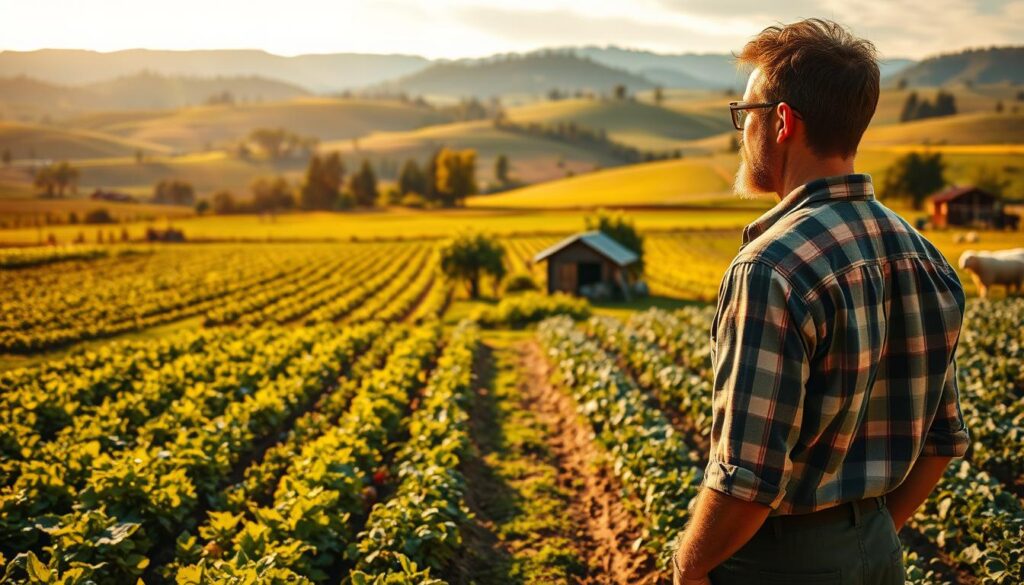
Exploring Options: Crop Production vs. Livestock Management
Deciding between crops and livestock involves several factors. Think about your knowledge, resources, and investment returns. Crop planning suits those who love botany and sustainability.
On the other hand, livestock management focuses on animal health and nutrition. It can lead to quicker profits in markets that value premium products.
Market Research: Identifying Demand and Setting Yourself Apart
Market research is vital before making a decision. Look at demand, profit margins, and sustainability. University programs offer insights into crops and livestock.
They help with the latest trends and technology. Finding what makes you unique helps you stand out and meet your market’s needs.
Land Selection and Acquisition Strategies
Starting a farm begins with finding the right land. We need to analyze and decide carefully. This ensures the land fits our farming goals.
Soil quality and climate are key when picking land. Soil fertility, drainage, and weather history matter a lot. We focus on these to support our farming plans.
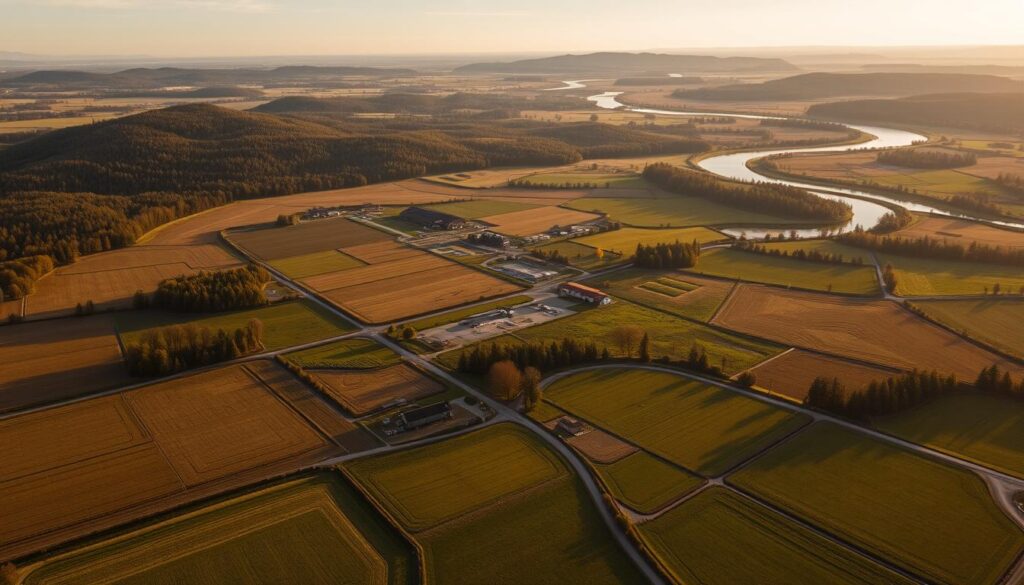
Having a steady water source is also vital. It affects what crops and animals we can raise. It also impacts the farm’s long-term health and the environment.
Here’s a comparison of leasing versus buying land:
| Aspect | Leasing Land | Buying Land |
|---|---|---|
| Initial Capital Requirement | Lower | Higher |
| Control Over Land | Limited | Full |
| Risk Exposure | Reduced | Significant |
| Long-term Investment | Not applicable | Beneficial |
Lastly, we look at how close the land is to markets and farm infrastructure. This affects costs and how well we can run the farm. Our strategy helps us choose land that meets both short-term and long-term needs.
Planning a Farm
Successful farm management starts with careful planning. Farmers must choose the right type of production and make sure it meets market needs and sustainability goals. Starting with organic farming practices is key.

Knowing what local markets want helps tailor our organic products. This boosts their appeal and acceptance. We also need strong farm management systems to keep up with organic standards.
Planning must include building the right infrastructure for daily and long-term success. This includes systems for water, soil health, and eco-friendly pest control.
| Component | Details | Impact on Sustainability |
|---|---|---|
| Soil Health Management | Implementation of organic fertilizers and crop rotation. | Enhances soil fertility and reduces erosion. |
| Water Management Systems | Installation of drip irrigation and rainwater harvesting systems. | Maximizes water use efficiency and ensures availability during dry spells. |
| Pest Management | Usage of natural predators and organic pesticides. | Minimizes chemical usage and protects biodiversity. |
Adding these elements to our farm planning supports sustainable farming. It also meets the growing demand for eco-friendly and ethically produced goods. By focusing on sustainable and organic farming, we ensure a profitable and sustainable farm.
Developing an Effective Farm Business Plan
Creating a solid farm business plan is key for both new and seasoned farmers. It acts as a guide, showing the way to profit and sustainability. To craft a good plan, you need to include details on how the farm operates, financial forecasts, and marketing strategies for farm products. Let’s explore the financial and marketing aspects vital for a farm’s success.
Financial Planning: Budgets, Forecasts, and Funding
Financial planning is at the heart of a good farm business plan. It covers startup costs, ongoing expenses, and cash flow predictions. Finding funding is essential, and looking into USDA grants and agricultural credit union loans is a good start. A well-made budget helps manage money and keeps the farm running smoothly.
Marketing Strategies: Reaching Your Target Audience
Marketing farm products well is key to a farm’s success. A good marketing plan targets the right audience, finds the most profitable markets, and builds strong relationships with places like farmers’ markets and restaurants. A strong brand helps your products stand out in a crowded market.

| Component | Description | Example |
|---|---|---|
| Operational Model | Outline of farming operations including type of crops or livestock | Crop rotation with corn, soybean, and wheat |
| Financial Projections | 5-year projection of income, expenses, and cash flow | Yearly increase in profit by 5% |
| Marketing Strategy | Plan for promoting products to target markets | Utilizing online platforms for direct-to-consumer sales |
By focusing on these key areas in your farm business plan, and with smart marketing, farmers can boost their market share and financial health. Detailed plans for managing finances and marketing are the foundation for a successful farm business.
Sustainable Practices in Farm Management
Embracing sustainable farming is key for our future. It respects nature, is good for the economy, and cares for the community. We focus on organic farming and eco-friendly pest control to keep our lands healthy.
Organic Farming Principles and Certifications
Organic farming is at the core of sustainable agriculture. It uses nature’s ways, supports biodiversity, and fits local needs. Farmers get certified to show they follow these rules.
This certification means no synthetic chemicals or GMOs. It helps keep soil and biodiversity strong. Getting certified takes three years of strict following of organic rules.
Farmers keep detailed records to prove their practices. This shows they are transparent and accountable. Getting certified boosts environmental care and makes farm products more appealing to buyers.
Implementing Eco-Friendly Pest and Weed Control
Controlling pests and weeds without harming the environment is vital. We use Integrated Pest Management (IPM) for this. IPM combines different methods to manage pests safely and effectively.
IPM builds strong ecosystems and reduces chemical use. It uses crop rotation, resistant plants, and natural predators. These methods keep farms productive and protect nature.
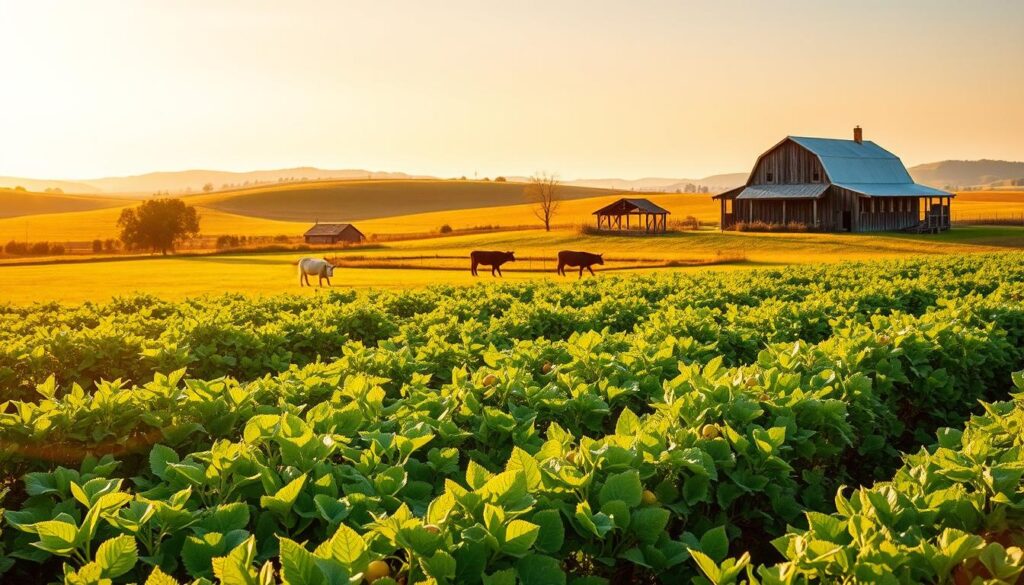
Essential Agricultural Skills for New Farmers
We help new farmers by teaching them both in classes and through hands-on work. It’s key to have good learning resources for farm businesses to start a successful farming career.
Training and Education Resources
Future farmers need to learn about modern agriculture. They should look for training from trusted groups. These groups teach about soil science, pest control, and sustainable farming.
By learning from these resources, farmers get better at managing their farms. They become ready for the challenges of farming.
Hands-on Experience: Internships and Volunteer Opportunities
Learning by doing is also very important. Internships and volunteer work give new farmers real experience. They can work with experienced farmers through programs like WWOOF or apprenticeships.
This experience helps them learn practical skills. It also shows them what farming is like every day. This helps bridge the gap between learning and doing.
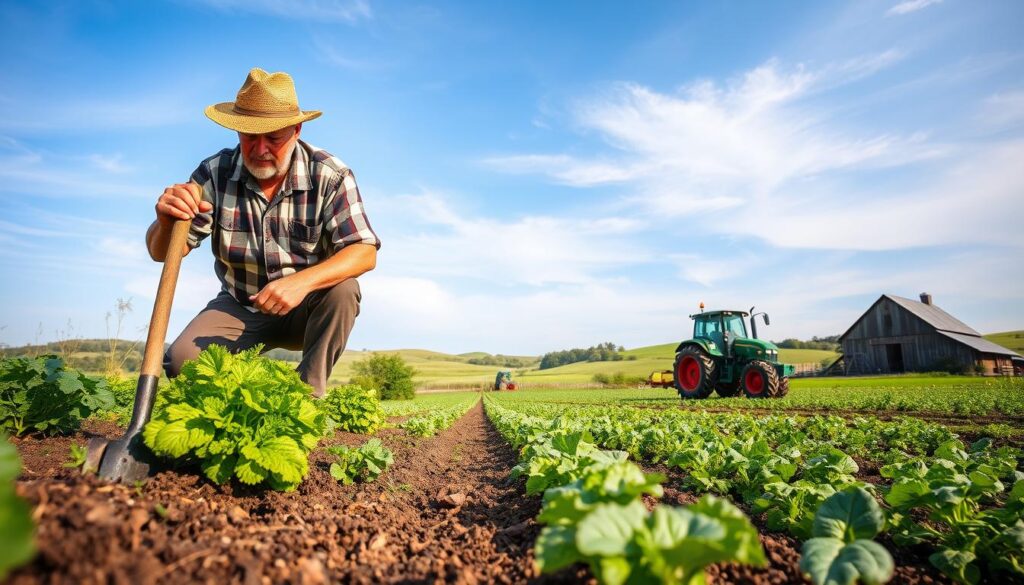
- Interactive workshops on organic farming requirements, often held by organizations such as CCOF or Oregon Tilth.
- Online platforms that cater to agronomic education, making learning easy for everyone.
- Specialized certification programs that prove a farmer’s skills and knowledge, helping them stand out in the market.
New farmers do well by using both learning resources and hands-on experience. This way, they can succeed in the changing world of farming. Education and practice together lead to a sustainable and productive farming future.
Leveraging Technology for Farm Efficiency
Modern technology is key to making farming better and more productive. Using farm management software and precision agriculture helps farms work smarter. This makes farming more efficient and productive.
Farm management software changes how we run farms. It tracks everything from money to harvests. This helps farmers make better decisions with the help of data.
Precision agriculture uses new tech like GPS and sensors. It helps grow crops better and saves resources. This way, farms can grow more with less waste and harm to the environment.
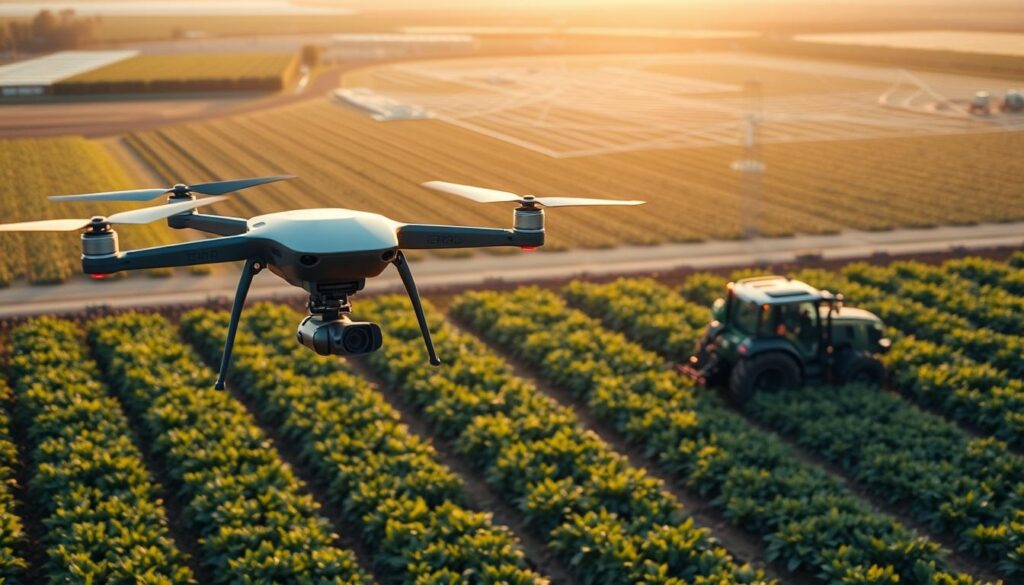
Together, farm software and precision agriculture help farms grow in a sustainable way. They make farming more efficient and reduce waste. This leads to a better future for farming.
Conclusion
We’ve explored the key steps to achieving success in farming. For those starting out, building a strong foundation is vital. This includes setting clear goals and evaluating the resources available, like land and money.
Choosing the right farming niche is also critical. It’s about understanding what the market wants and what makes our products special. This helps us stand out in a crowded market.
Our commitment to sustainable farming is important for the planet and our farm’s future. By using organic methods and eco-friendly pest control, we meet consumer expectations. A detailed business plan is also essential for success in farming.
Technology has changed farming for the better, making it more efficient. By using farm management software and precision agriculture, we improve our work. With the right skills, a flexible approach, and a solid plan, we’re on the path to success.
For those starting their farming journey, combining knowledge, innovation, and planning is key. It’s the foundation of a successful agribusiness.
FAQ
How do I determine my farming goals and visions?
Start by thinking about why you want to farm. Is it for profit, a better lifestyle, to care for the environment, or animals? Think about what you love and how you see your farm. This will help you plan and guide your farm’s future.
What resources are necessary to start a farm?
To start a farm, you need land, water, and people to help. You also need money for the beginning and ongoing costs. Don’t forget equipment, seeds, and buildings to keep everything running smoothly.
How do I choose between crop production and livestock management?
Choosing between crops and animals depends on your interests and skills. Look at what people want to buy and what others are selling. Think about what you like and what it takes to care for each.
How important is market research in farm planning?
Market research is key for planning your farm. It shows what people want to buy and helps you set prices. It also helps you stand out and find where to sell your products.
What should I consider when selecting land for my farm?
When picking land, think about its location, water, soil, and climate. Check the soil and see if you need buildings. Also, make sure it fits with nearby farms and local laws.
How do I secure sustainable water sources for my farm?
To find sustainable water, look at the land’s water sources and existing rights. Use water wisely and invest in good irrigation. Follow local rules for water use.
What should be included in a farm business plan?
Your business plan should have a mission statement and details on how you farm. Include financial plans, marketing, and who you’re selling to. It should also cover your products and how you’ll brand them.
How can I fund my farming operation?
You can use your own money, loans, grants, or investors. Consider crowdfunding or CSA subscriptions for extra help with costs.
What are some sustainable practices in farm management?
Use organic methods, improve soil with compost, and save water. Rotate crops and manage pests without harming the environment.
What certifications are available for organic farming?
The USDA organic certification is the main one in the US. It means you follow strict organic rules for three years. You’ll need to keep records and pass inspections.
How do I gain the agricultural skills necessary for successful farming?
Learn through school, internships, or volunteer work. Local groups offer workshops and resources for sustainable farming.
Why is farm management software important?
It helps you track finances, planting, and more. This info is key for planning and making smart decisions to improve your farm.
What is precision agriculture and how can it benefit my farm?
It uses tech like GPS and sensors to improve farming. It makes farming more efficient, saves resources, and helps the environment.